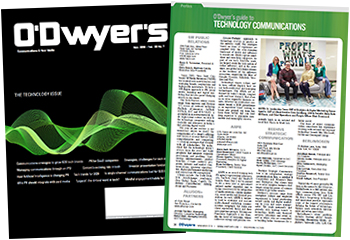 Heather Kernahan Heather Kernahan |
In a sense, the future is already here. “Humans Still Needed,” a 2018 CIPR report analyzing skills and tools in the industry, found that the market for AI tools in public relations is “exploding,” with more than 120 such tools already available.
Doom-mongers might paint this as a bot army at the gates. But this is really a liberating force. As the CIPR report states: “Many experts agree that AI will help more than hurt white collar workers by freeing them from more mundane tasks and allowing them to concentrate on innovation and creativity.”
 |
| This article is featured in O'Dwyer's Nov. '19 Technology PR Magazine. |
And it’s a refrain taken up by "PR:Tech," the 2019 global communications report by USC Annenberg Center for Public Relations, which asserts: “As the PR profession adopts new technology, PR professionals will need to adopt new skills. Machines may do the analysis, but intelligent humans will be required to translate data into actionable insights. Those insights will be expressed visually, which increases the need for production and design capabilities.”
That aligns with our thinking in Hotwire. AI is not only a boon for our tech clients, it’s great for our business too.
We don’t want bright minds in our business to feel frustrated and on the path to burnout because of tedious hours staring at spreadsheets. Rather, technology is revolutionizing the way we work and generating new opportunities at a dizzying rate.
Investing in the best technology will increasingly free our people from dreary, repetitive tasks, allowing them to provide real value by devoting their time to strategy, creativity and delivering amazing client service. I say “increasingly” because for us the journey has already begun.
What makes this possible is our “tech stack,” a collection of tools and services that provide our people with insights, data and analytics. We evaluate every tool in our stack yearly to make sure we are using “best in industry.”
These tools vary from the expected such as media monitoring to the more advanced behavioral analytics, influencer identification and predictive PR responses. We’ve moved away from the outdated mentality that for decades held sway in communications planning and measurement to become more proactive, data-driven and geared toward making our clients thought and industry leaders. Our technological edge is helping clients gain a valuable edge of their own in the highly competitive markets in which they operate.
Internally, we give our people the choice between PC or Mac laptops but ensure our teamwork is speedy and smooth by using collaborative enterprise solutions such as Zoom, Slack and Egnyte. As you’d imagine, we’re big on the cloud.
Ensuring our people are tech savvy goes beyond boosting efficiency. It helps build understanding of our clients’ tech products, leading to better communication programs and results.
Those agencies that don’t adapt to embrace the opportunities brought by new technologies will be left behind yet it’s clear many agency managers have yet to grasp the significance of what’s going on. Research for the USC Annenberg Center report mentioned above found that only 18 percent of PR professionals believe AI will be “very important” in PR work.
Yet when the same question was put to PR students, a majority (53 percent) agreed. The generation soon to enter the workforce is more aware then those making decisions today that will set the direction of the agencies of the future.
This brings me to what we look for in our new hires. Creativity is a must. As LinkedIn research shows, it is the most in-demand soft skill of 2019. Its rise is no surprise. Back in 2016, the World Economic Forum’s influential “The Future of Jobs” report projected that creativity would leap from 10th place to 3rd most important skill in the workplace between 2015 and 2020.
However, creativity must be accompanied by data knowhow. In the next five to 10 years, we will need to teach every employee how and when to use data. We will all become some degree of data scientist. More and more, our business will hinge on taking data and converting it into something creative or strategic.
AI will do the data crunch heavy lifting. Yet we must be mindful of the saying that while a robot can do the work of 50 people, at the same time, 50 robots can’t do what one person does.
Not only will AI be able to rattle through large data sets, its openness to patterns and correlations is rather like a child’s mind. It throws up potential connections we would not set out to look for. What, if anything would it mean if there was a spike in social media usage just after a TV commercial for a funeral parlor? Or an ice cream brand? Nothing at all, a red herring? Or something important that would otherwise have been overlooked?
This is where the subtlety and cultural intelligence of the human mind comes into play. It will be about interpreting data into valid insights and then applying market knowledge and creative chops to come up with killer strategies and content.
The need for this subtlety and imagination is growing fast because the march of AI is gathering momentum. As The New York Times reported earlier this year under the headline “The Rise of the Robot Reporter,” some form of automated technology is used in around a third of the content published by Bloomberg News. That translates into thousands of articles on company earnings reports each quarter.
“In addition to covering company earnings for Bloomberg,” the newspaper noted, “robot reporters have been prolific producers of articles on minor league baseball for The Associated Press, high school football for The Washington Post and earthquakes for The Los Angeles Times.”
Meanwhile, the AI-powered content management system at Forbes is playfully named Bertie in honor of the magazine’s visionary founder Bertie Charles Forbes, who once said: “If you don’t drive your business, you will be driven out of business.” How true.
We’re looking to technology and AI in particular to drive our business forward, because our intention is to carry on growing rather than being driven into oblivion. And we all can learn from each other as we build our own tech stacks and integrate AI into our organizations. Read everything, talk about this everywhere, try new tech and processes. All of this will keep us from the shackles of the mundane.
***
Heather Kernahan is President North America and Australia, Hotwire.


 Laura Anderson, who rose to VP/GM of global communications and events in a nearly 20 year stint at Intel, will take on the Americas technology chair at Burson following the completion of the BCW and H+K merger on July 1.
Laura Anderson, who rose to VP/GM of global communications and events in a nearly 20 year stint at Intel, will take on the Americas technology chair at Burson following the completion of the BCW and H+K merger on July 1. WE Communications has partnered with ROKK Solutions to form the WE ROKK AI service.
WE Communications has partnered with ROKK Solutions to form the WE ROKK AI service. In the dynamic world of modern business, effective communication is a pivotal tool for success across various industries. At Communications Strategy Group (CSG®), our expertise in embracing innovation in communication extends beyond traditional marketing strategies, paving the way for transformative industry-specific solutions.
In the dynamic world of modern business, effective communication is a pivotal tool for success across various industries. At Communications Strategy Group (CSG®), our expertise in embracing innovation in communication extends beyond traditional marketing strategies, paving the way for transformative industry-specific solutions. There are two types of tech PR professionals. Which one are you? And are C-suite executives making that decision for you?
There are two types of tech PR professionals. Which one are you? And are C-suite executives making that decision for you? While there’s an impulse to grab reporters’ attention with the newest industry-transforming tech product or service, a back-to-basics approach focused on telling the right stories to the right people is a far more successful way to ensure your technology campaign breaks through the clutter of today’s crowded tech landscape.
While there’s an impulse to grab reporters’ attention with the newest industry-transforming tech product or service, a back-to-basics approach focused on telling the right stories to the right people is a far more successful way to ensure your technology campaign breaks through the clutter of today’s crowded tech landscape.


 Have a comment? Send it to
Have a comment? Send it to 
No comments have been submitted for this story yet.